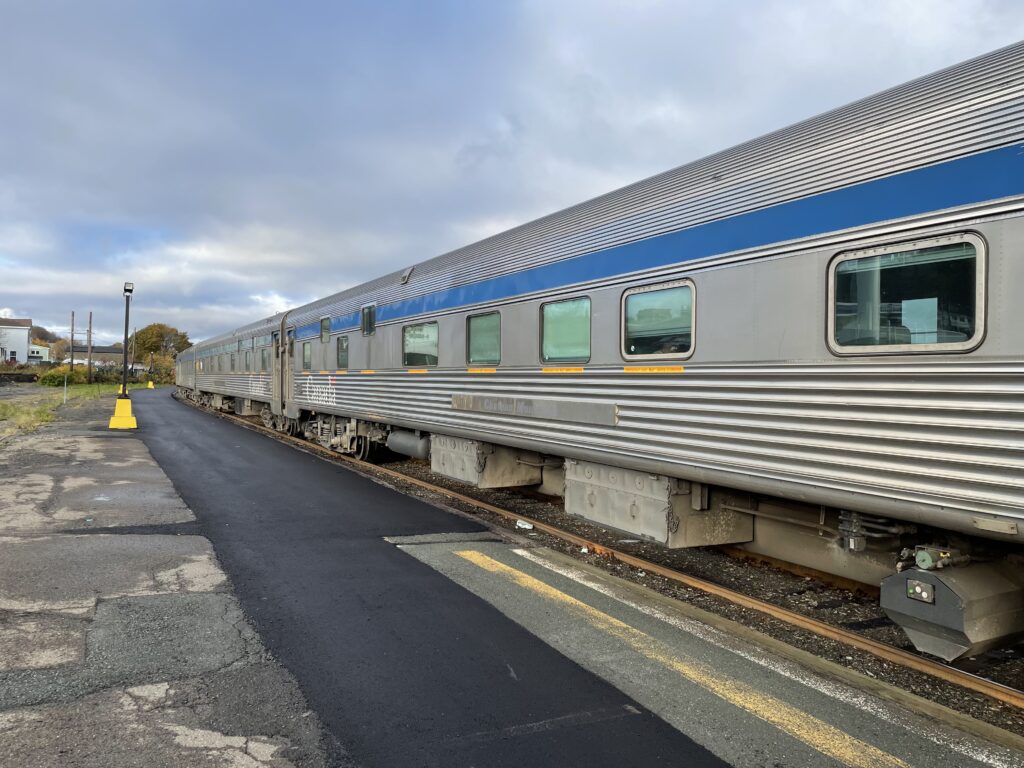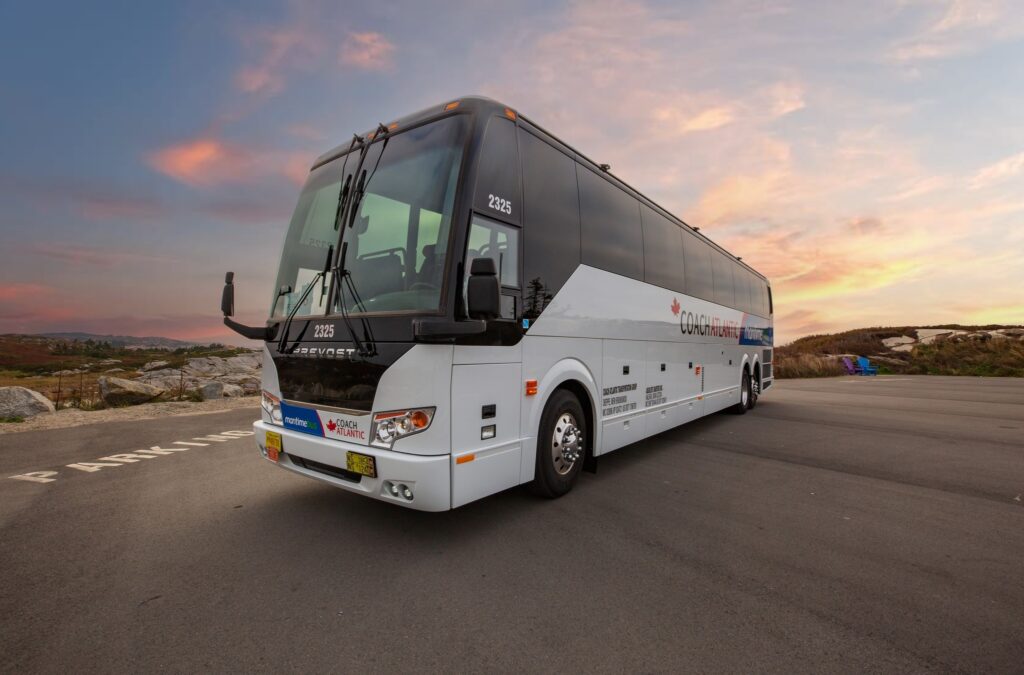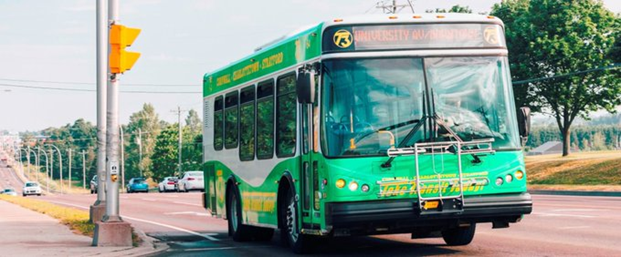Welcome to the November/December edition of Atlantic Transport News! With the holidays quickly approaching, this may well turn out to be our last newsletter for the year. All of us at TAA wish you a happy and healthy holiday season!
Here’s a look at what you’ll find in this edition:
- VIA’s 3rd Quarter report shows ridership returns, highlights dire equipment issues
- Maritime Bus marks 10 years of operation
- Marine Atlantic reports successful summer
- Charlottetown’s T3 Transit continues to set records
- PAL Airlines encouraged with NB-NL service
- “Bark and fly” at Halifax airport
- Nova Scotia transit operators receive COVID relief funding
VIA 3RD QUARTER REPORT SHOWS RIDERSHIP RECOVERY, BUT HIGHLIGHTS DIRE EQUIPMENT SITUATION

VIA Rail Canada recently released its 3rd quarter report for 2022. The overall ridership picture is positive. For the Ocean, ridership this quarter was up to 23,000, a whopping 505.3% increase over 2021, thanks, no doubt, to the increase from 1/week and then 2/week service back up to the full 3/week service in 2022. Revenues also increased by 514.3% over 2021. VIA’s figures put the increase in capacity in terms of seat miles at 429% for the quarter.
Comparing figures to pre-pandemic ridership, the Ocean carried 29,500 passengers in Q3 2019, and 29,000 in Q3 2018. By this comparison, Q3 2022’s figure of 23,000 is lower than pre-pandemic totals. It’s difficult to determine exactly what is behind this relative figure; a slow return to pre-pandemic travel patterns may be one factor, but limited capacity may be another. The new bidirectional Ocean consists offer less passenger capacity than the previous configurations, in part due to equipment constraints, but also due to staffing shortages that prevented running longer trains. Many trains through the summer months were sold out, and it’s hard to say how many more passengers VIA could have carried had they been able to run longer trains and offer more space for sale.
The Q3 report is otherwise light on details, but the Risk Analysis section is notable. “Asset Management” is highlighted as an increasing risk, and the report states “The Corporation’s HEP rolling stock equipment has essentially reached the end of its operating life. Its reliability has deteriorated in the past few years, resulting in delays and additional operating costs to maintain a state of good repair. Maintenance costs are projected to increase significantly in upcoming years until a replacement fleet of equipment is introduced, both in the Corridor where the Corporation counts on 31 HEP2 coaches representing more than 25 per cent of current Corridor capacity and non-Corridor services, as reliability of the aging fleet will continue to deteriorate, as well as all of the non-Corridor services who depend on HEP equipment to provide services to communities.” This follows on comments made in recent VIA annual reports and corporate plans, and comes on the heels of recent developments that have shone an even greater spotlight on the dire situation facing the bulk of VIA Rail’s equipment fleet.
Thanks to an Access to Information request, railway blogger Eric Gagnon was able to acquire and publish a copy of the summary report provided by Hatch Engineering, which prompted the most recent inspections and tests of HEP equipment, as well as the “buffer car” policy. Eric posted the report in full on his Trackside Treasure blog.
Here are a couple of notable excerpts:
“As fleetwide inspections continued during the Heritage Program, the findings suggested that all HEP cars likely have some degree of structural degradation of the strength of the car body.“
“The conditions identified on the HEP fleet do not affect the structural performance of the HEP cars under normal operating loads, meaning that they will not fail in regular service….Unfortunately, in most cases, the remaining car body strength of the HEP fleet cars is likely less than original design standards.“
“Considering the age of the current fleet and the planned operation until 2035, Hatch has provided VIA Rail with key recommendations around fleet replacement, a structural reinforcement program for the current fleet, temporary operational mitigations and updates to VIA’s risk assessment to support decisions around proposed mitigation measures.“
Perhaps most notable is this first of the key recommendations:
“Initiate a replacement program for the HEP fleet. By 2035, most of VIA’s HEP fleet will be greater than 80 years old. Considering the age of the fleet, continued deterioration due to corrosion is expected despite any further mitigations taken in the interim. The only long-term solution is the replacement of the fleet.”
In the interim, Hatch also provided recommendations for inspection and repair work to ensure that the HEP fleet remains in safe operating condition. “Buffer cars” will remain in place while this work is being done, and can hopefully be removed once suitable repairs are complete. In any case, it is becoming increasingly clear that VIA is in urgent need of a replacement for its long distance fleet. The HEP fleet can simply no longer be rebuilt indefinitely, and the Renaissance fleet that makes up the balance of the Ocean’s equipment pool is also past its initial planned withdrawal date. Train services from coast to coast are in severe jeopardy if no replacement is sought in as timely a fashion as possible. VIA has reportedly already submitted a business case for the fleet replacement to Transport Canada. It’s well past time for the federal government to take note, and provide VIA with the go ahead to launch this desperately needed procurement.
Meanwhile, day to day on time performance of the Ocean has finally improved from the routine delays during the late summer and fall, as track work programs in Quebec are complete. With train 15 routinely back on schedule, VIA has restored the earlier connection to Ottawa on train 35. For Toronto or southwestern Ontario bound passengers, VIA is still only guaranteeing a connection with the later train 67, which requires a 3 hour layover in Montreal. The connection to the earlier train 65, which would require only a 57 minute connection and arrive in Toronto over 2 hours earlier, is shown as returning as of January 12, 2023. It’s not clear why the return of this connection has been delayed.
The Christmas holidays promise to be a busy travel time in the Maritimes, as usual. There are no extra trains for the holidays this year, and no schedule adjustments either, as even the trains scheduled for Dec. 25th will still run on their usual day and schedules. However, after having only 2 trains a week running by this time last year, the return of the full 3/week service still marks an increase over the past season. There is evidence that VIA has added additional passenger capacity to these trains, based on increased inventory in the reservations system, but even with added equipment several trains are fully sold out for end-to-end travel several weeks in advance. This was no doubt aided by a recent “Black Friday” sale, which included holiday-time travel (with no blackout dates) for the first time in several years. Bus shuttle service continues to be provided to connect passengers in the Gaspe via Campbellton. In any case, it is encouraging to see that passengers are coming back to the train, even after the hiatus of service – hopefully, VIA will take note!
-Tim Hayman
HAPPY BIRTHDAY! MARITIME BUS MARKS 10 YEARS IN OPERATION

In the summer of 2012, travellers in the Maritimes were shocked by the news that Acadian Lines, the sole intercity bus service in the region, would be shutting down operations entirely after November 30th. Coupled with news that VIA’s Ocean service would be cut in half (from 6 to 3 days a week operation) at nearly the same time, this marked a staggering blow to the intercity public transportation network in the region. Mike Cassidy, owner of Coach Atlantic, was similarly shocked by the news – but also saw an opportunity to step in to fill the void. Thus, Maritime Bus was born, and officially started operations on December 1, 2012.
This December 1st marked 10 years of operation for Maritime Bus. The road hasn’t always been smooth, especially through the recent years of the pandemic, but the carrier has continued to provide bus service through New Brunswick, Nova Scotia, and PEI, and has worked to continue expanding their network as opportunities arise. Key to that success has been Cassidy’s commitment to providing scheduled bus service through the region. Speaking with CBC News, Cassidy said of his decision to launch Maritime Bus: “We just said … busing is needed in the region and we are the ones to do it, and that’s how Maritime Bus started.”
Here’s to the next 10 years!
MARINE ATLANTIC REPORTS SUCCESSFUL SUMMER

Was it the relaxation of public health restrictions, the Come Home Year promotion launched by the provincial tourism department, or simply an explosion of pent-up demand by ex-pat Newfoundlanders? Whatever the reason, passenger traffic on Marine Atlantic ferry service showed a dramatic recovery in July and August. The Crown corporation accommodated nearly 160,000 customers during that two-month period this past summer. That’s almost 20,000 more riders than the service carried in the same period in 2019 – the last pre-pandemic tourist season.
The figures were given at the company’s annual public meeting on October 20, at which the Annual Report for the fiscal year ending March 31 was released. CEO Murray Hupman was clearly pleased at the resurgence in traffic, but wasn’t entirely sure why the summer was so successful.
“Is it the new normal? We’re not certain. But it definitely was a rebound from the previous two years,” he told CBC News. Whether this summer’s impressive ridership will enable the corporation to meet the controversial 65% cost recovery target set by Transport Canada remains to be seen. They failed to meet the target in 2021-22, as expenses increased and traffic continued to be affected by the pandemic. The federal subsidy requirement for the year was $131 million.
Interestingly, ferry traffic to Newfoundland is rebounding at a much higher rate than air travel, according to Colin Tibbo, Marine Atlantic’s chief information officer, who also holds responsibility for the customer experience portfolio. The often-chaotic conditions experienced at some of the country’s busier airports this summer may help explain why. But there are other factors at play, including the severe shortage of rental vehicles this year – a factor that’s especially critical at a destination where having a car is considered a necessity to enjoy the full visitor experience.
Marine Atlantic’s customer satisfaction ratings are showing a slight decline this year compared with 2021 scores, but that was not unexpected, Mr. Tibbo said. The levels recorded during the pandemic were “unrealistically high” he noted, and maintaining ratings received under such unusual circumstances wasn’t a reasonable expectation. Nevertheless, the most recent scorecard from Narrative Research shows that 78.7% of customers are “highly satisfied” with their crossing, and 95.2% say they would recommend Marine Atlantic. Not surprisingly, the lowest rating went to “value for money” with only 64.1 % of respondents viewing it positively.
You can view Marine Atlantic’s 2021-22 Annual Report here:
https://www.marineatlantic.ca/sites/default/files/2022-10/Annual-Report-2021-2022.pdf
In a late development, Marine Atlantic announced a ground-breaking five-day Black Friday sale on passenger and passenger vehicle fares, with a 50% discount offered on every sailing between Port aux Basques and North Sydney from November 24 through January 8. This includes the entire Christmas-New Year travel period, with no blackout dates. Onboard accommodations, meals, fuel surcharges and security charges are excluded from the discount, but the sale is strong incentive to travel in what is largely a slow period for passenger travel on the ferries.
CHARLOTTETOWN’S T3 TRANSIT CONTINUES TO SET RECORDS

While urban public transportation across Canada is at long last winning back significant slices of traffic lost because of COVID-19, Charlottetown’s T3 Transit is showing phenomenal growth in 2022. The city-funded but privately operated service just set another new monthly record for ridership with over 106,000 trips recorded in October. That’s an increase of nearly 38 percent from July – just three months previous. Canada’s smallest capital city is riding the crest of a nationwide trend, but appears to be leading the pack both nationally and regionally.
According to data released by Statistics Canada on November 21, transit services countrywide in September had recovered ridership to about 73.5 per cent of what it was in the corresponding month of 2019. The agency reported that the number of urban transit passenger trips in Canada hit a pandemic-era high, reaching 120.6 million for the first time since the COVID alarm sounded in March of 2020.
More employees returning to the workplace, along with schools reopening, were suggested as the reason behind the positive results.
The StatsCan data showed a total of 120.6 million riders on urban transit coast-to-coast in September 2022, an increase of 25.4% from May. Atlantic Canada overall showed a significantly stronger resurgence than the national average, with the region reporting 2.5 million passengers carried for the month, up 31.6% from May.
Meanwhile, the PEI Government will continue to subsidize both urban and rural transit on the Island until at least the end of the current fiscal year. Transportation Minister Cory Deagle announced the extension of the $20 monthly pass on October 27. The incentive to wean Islanders away from private automobile use has been in effect since June. The cost of a monthly pass for seniors and post-secondary students is just $10, while children and students from K-12 ride for free.
PAL AIRLINES ENCOURAGED WITH NB-NL SERVICE

PAL Airlines sees plenty of traffic potential on its routes between Newfoundland and New Brunswick – even though it has temporarily discontinued service to Fredericton. The regional airline’s fall schedule shows service six days a week between Moncton and St. John’s, with a stop at Deer Lake. This frequency remains in effect up to and including the Christmas travel period. The same aircraft provides service between Moncton and Ottawa three days a week, and runs to Mont-Joli and Wabush on alternate days.
Janine Browne, director of business development and sales, says there’s a strong demand for service between the two provinces with both YYT and YDF generating significant traffic. Not sufficient, evidently, to justify at this time of year the non-stop routing between YQM and YYT that was part of the summer schedule. But although the exact schedule for the new year hasn’t yet been announced, indications are that PAL will continue to offer service consistent with anticipated demand through the winter.
BARK AND FLY AT HALIFAX STANFIELD

While there may be a dark cloud of uncertainty hanging over Halifax Stanfield International Airport about the future of WestJet’s seasonal overseas services that may or may not be back in 2023, there’s a new business at YHZ that has tails wagging.
Air Buddies Pet Services is an overnight pet boarding facility located conveniently in the terminal building. It’s billed as a unique service for both travellers and those employed at the airport. Additional services are coming soon, including dog daycare, grooming, and retail.
NOVA SCOTIA TRANSIT OPERATORS RECEIVE COVID RELIEF FUNDING
Transit systems reeling from the impacts of the COVID-19 pandemic are seeing some financial relief, as a joint federal-provincial funding program will provide one-time payments to transit operators to help compensate them for lost revenues. The $10.9 million grant will be distributed to a total of 28 transit operators across the province, with $8.6 million going to Halifax Transit, $359,809 to Cape Breton Transit, $332,392 to Kings Transit, and the remainder going to a variety of fixed route and community operators.






